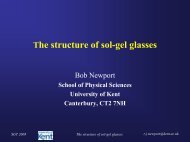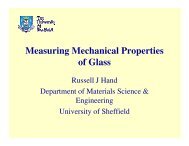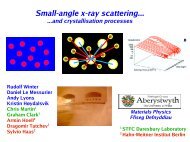Download full presentation (pdf, 4MB) - Students.sgthome.co.uk ...
Download full presentation (pdf, 4MB) - Students.sgthome.co.uk ...
Download full presentation (pdf, 4MB) - Students.sgthome.co.uk ...
Create successful ePaper yourself
Turn your PDF publications into a flip-book with our unique Google optimized e-Paper software.
Glass Doping through Sol-Gel Chemistry :<br />
a little something<br />
can make a big difference<br />
Jean-Marie Nedelec<br />
Laboratoire des Matériaux Inorganiques, CNRS UMR 6002 ,<br />
Université Blaise Pascal, Clermont-Ferrand 2<br />
& E<strong>co</strong>le Nationale Supérieure de Chimie de Clermont-Ferrand<br />
FRANCE<br />
Society of Glass Technology Annual meeting, (10-12 September, Cambridge, UK)
PARIS<br />
CLERMONT-FERRAND<br />
MONTPELLIER
Port Doctoral position<br />
opening – 1 year<br />
J-marie.nedelec@univ-bpclermont.fr
Outline<br />
Introduction<br />
Silica xerogels : Effect of doping on the densification<br />
pathway<br />
Bioceramics : Improved bioactivity of doped ceramics<br />
Conclusions
Introduction<br />
Doping = atoms, ions, molecules,…<br />
= FUNCTION<br />
Optical, magnetic, biological,<br />
electrical,…<br />
= STRUCTURE<br />
Phase, hardness,<br />
microstructure
Introduction<br />
Sol-Gel Chemistry<br />
Nanoparticles<br />
Gel<br />
Powder<br />
Doping<br />
Thin films<br />
Very versatile route, high homogeneity,<br />
good dispersion of doping ions
Doped Silica xerogels<br />
Doping with rare earth ions, TM ions, dyes, biomolecules,…<br />
No effect of doping on the structure of the gels
2,2<br />
2,0<br />
1,8<br />
SiO 2<br />
SiO 2<br />
: Ag +<br />
SiO 2<br />
: Ce 3+<br />
Density (g/cm 3 )<br />
1,6<br />
1,4<br />
1,2<br />
1,0<br />
0,8<br />
0,6<br />
800 850 900 950 1000 1050 1100 1150<br />
Annealing Temperature (°C)
D 1<br />
δ Si-O-Si<br />
D 2<br />
ν Si-OH<br />
1100°C<br />
Intensity (a.u.)<br />
1050°C<br />
1000°C<br />
950°C<br />
900°C<br />
850°C<br />
800°C<br />
0 200 400 600 800 1000 1200<br />
Raman shift (cm -1 )
Normalized Raman Intensity<br />
0,060<br />
0,055<br />
0,050<br />
0,045<br />
0,040<br />
0,035<br />
0,030<br />
0,025<br />
750 800 850 900 950 1000 1050 1100 1150 1200<br />
0,04<br />
0,03<br />
0,02<br />
D1<br />
Si-OH<br />
0,12<br />
0,10<br />
0,08<br />
0,06<br />
0,04<br />
0,02<br />
0,00<br />
750 800 850 900 950 1000 1050 1100 1150 1200<br />
0,84<br />
0,80<br />
0,76<br />
0,72<br />
Si-O-Si<br />
D2<br />
0,01<br />
0,68<br />
0,00<br />
750 800 850 900 950 1000 1050 1100 1150 1200<br />
0,64<br />
750 800 850 900 950 1000 1050 1100 1150 1200<br />
Annealing Temperature (°C)<br />
J. Sol-Gel Sci. Techn. 32 (2004) 345-348<br />
J. Non-Cryst. Solids, 345-346, (2004), 570-574.
Low-frequency Raman spectra<br />
SiO 2 : Mn 2+<br />
Suprasil<br />
Intensity (a.u.)<br />
0 ppm<br />
200 ppm<br />
500 ppm<br />
-100 -50 0 50 100<br />
Raman shift (cm -1 )<br />
J. Non-Cryst. Solids, 243, (1999), 209
Duval et al., Phil. Mag. B 77 (1998)<br />
2.24 nm<br />
11.1 nm<br />
2.9 nm<br />
Suprasil<br />
undoped<br />
Mn 2+ 500 ppm<br />
0 20 40 60 80<br />
ω (cm -1 )
Bioactive Ceramics<br />
Need for improved bone replacement materials<br />
Bioactive ceramics<br />
Crystalline : HAP Amorphous : Bioglass ®<br />
Control of bioactivity and new functions through<br />
- doping<br />
- <strong>co</strong>ntrol of porosity
Bioglass ® (L.L. Hench et al.)<br />
bioactive<br />
Inert/fibrous<br />
capsule<br />
Resorbable<br />
10-30 d<br />
Na 2 O-CaO-P 2 O 5 -SiO 2<br />
Bioactivity = function (<strong>co</strong>mposition)<br />
Sr – doped glasses
Sol-Gel elaboration of doped bioactive glasses<br />
Ca(NO 3 ) 2 ,4H 2 O<br />
Si(OEt) 4<br />
O=P(OEt) 3<br />
Monolith<br />
(Ca,P,Si) sol<br />
Gel<br />
Doping : + Sr(NO 3 ) 2<br />
Reflux @ 85 °C Drying @ 60°C<br />
Powder<br />
Treatment<br />
24 h @ 700 °C
Mesoporous Bioactive glass<br />
monoliths<br />
250,00<br />
Adsorption<br />
Desorption<br />
200,00<br />
Volume (cc.g -1 )<br />
150,00<br />
100,00<br />
50,00<br />
1.5 cm<br />
0,00<br />
0,00 0,10 0,20 0,30 0,40 0,50 0,60 0,70 0,80 0,90 1,00<br />
P/P0<br />
SSA between 70 and 150 m 2 /g
150 °C<br />
450 °C<br />
10 nm 15 nm<br />
600 °C<br />
700 °C<br />
20 nm 15 nm
In vitro assays<br />
└►In vitro assays allow important evaluation for the bioactivity of glasses<br />
Immersion in<br />
biological fluids<br />
(DMEM) for<br />
varying periods<br />
:<br />
up to 4 days<br />
soaking<br />
Glass particles<br />
are embedded in<br />
resin<br />
Samples are cut into thin<br />
sections 1 µm thick<br />
Micro-PIXE-RBS<br />
characterization
Ion and electron beams methods<br />
Ion beam analysis at the micrometer scale<br />
Micro-beam lines<br />
PIXE : Particles Induced X-ray Emission – Multi-elementary analysis<br />
Resolution : 1 µm at 50 pA<br />
Experimental set-up<br />
Si(Li) diode at 135°<br />
Data Treatment<br />
Gupix <strong>co</strong>de<br />
Concentrations measurements : Z > 11 (Na), sensitivity ≈ 1 µg/g<br />
Elemental maps : 10x10 µm 2 –2x2 mm 2<br />
Major elements<br />
Trace elements<br />
Ca, P, Mg, Si, Zn, Sr, K, Na, S …
Ion and electron beams methods<br />
Ion beam analysis at the micrometer scale<br />
Micro-beam lines<br />
RBS : Rutherford Backscattering Spectros<strong>co</strong>py<br />
Elastic diffusion of the incident ion by nucleus in the target (Coulomb interaction)<br />
Experimental set-up<br />
Si diode at 135°<br />
Data Treatment<br />
SimNRA <strong>co</strong>de<br />
Rumpin <strong>co</strong>de<br />
Resolution : 1 µm at 50 pA<br />
Stoechiometric : Z > 5 (B) ; C, N, O….<br />
Sample weight, irradiation damages<br />
Deposited charge (to calculate <strong>co</strong>ncentrations with PIXE)
Experimental device: the CENBG microbeam line<br />
Ion source<br />
H + , He +<br />
Singletron electrostatic accelerator<br />
Proton beam of 1.5 MeV energy; ∆E/E = 2.5x10<br />
500 pA intensity<br />
Size of the spot: 1 µm m x 1µm1<br />
10 ─5<br />
Experimental set up<br />
Collimator<br />
Russian quadruplet<br />
PIXE<br />
STIM<br />
Switching magnet<br />
Collimator<br />
Electrostatic<br />
scanning plates<br />
RBS
PIXE-RBS study of interactions<br />
SiO 2 75 % -CaO 25 % glass<br />
Si<br />
Ca<br />
P<br />
After 15 minutes of interaction
Si<br />
Ca<br />
P<br />
Mg<br />
After 1 hour of interaction
Influence of doping 5 % Sr<br />
Si<br />
Ca<br />
P<br />
4 days<br />
Sr<br />
Mg<br />
-Doped glass reacts more slowly<br />
-The Ca/P peripherical phase is still present after 4 days
Evolution of Ca/P ratio in the periphery<br />
Un-doped glass<br />
5 % Sr-doped glass<br />
Time (days)<br />
Time (days)<br />
Chem. Mat. 20 (2008) 4969
SiO 2 -CaO 5 days
SiO 2 -CaO-P 2 O 5<br />
5 days<br />
J. Phys. Chem C 112, (2008) 9418
Sr 2+ delivery in solution<br />
15<br />
Concentration (ppm)<br />
10<br />
5<br />
0<br />
0 2 4<br />
Interaction time in DMEM (days)
Conclusions<br />
Flexibility of the process<br />
NEW MATERIALS<br />
Better dispersion<br />
HIGH HOMOGENEITY<br />
Doping<br />
STRUCTURAL MODIFICATION<br />
Doping species<br />
NEW FUNCTIONALITIES
Acknowledgements<br />
Université Clermont-Ferrand<br />
E. Jallot<br />
J. Lao<br />
L. Courthéoux<br />
J. Soulie<br />
Université Lille<br />
S. Turrell<br />
C. Kinowski<br />
M. Bouazaoui<br />
B. Capoen<br />
Université Paris 7<br />
J.M. sautier<br />
S. Loty<br />
University Trento<br />
M. Ferrari<br />
Université Bordeaux<br />
CENBG<br />
P. Moretto<br />
FNS & FRT LuminiX and LuNaTIC, ANR PNANO 2005 & 2006, INSERM Pro A for funding





